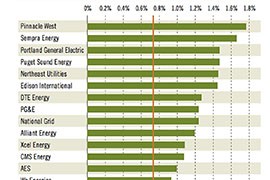Cronkite News has moved to a new home at cronkitenews.azpbs.org. Use this site to search archives from 2011 to May 2015. You can search the new site for current stories.
Report: Pinnacle West saw highest increases in energy efficiency in 2012
WASHINGTON – Arizona Public Service was able to improve efficiency by about 1.8 percent through programs it instituted in 2012, the biggest savings rate that year among large public utilities nationwide, according to a recent report.
Pinnacle West, the holding company that owns APS, was still only 11th overall for total efficiency savings from programs over the years among the 32 utilities studied by Ceres, an organization that promotes sustainability.
But the 2012 numbers show that APS is gaining ground on the others, in part because state efficiency rules have started to kick in, experts said.
Jim Wontor, manager of energy efficiency programs at APS, said that while the utility has engaged in energy efficiency practices since 2006, the jump in 2012 is partly because the Arizona Corporation Commission in 2010 set efficiency standards requiring 22 percent energy savings by 2020.
“While we had been doing these programs prior to 2011, they ticked up even a little bit more in 2011 and 2012 as a result of the standard that the Arizona Corporation Commission had passed,” Wontor said.
He cited initiatives for both businesses and homes that created such high savings in 2012. Incentives on new efficient equipment for businesses, variable-speed pool pumps and a greater push for fluorescent light bulbs were some of the programs he said helped customers save on their energy use.
The rankings reflect the full scope of energy efficiency programs used by APS, according to Dan Bakal, director of electric power at Ceres.
“To hit numbers like that, you have to being doing a pretty comprehensive suite of energy efficiency programs,” Bakal said.
APS’ 2012 savings of 1.8 percent compared to national average of 0.73 percent for that year, according to the report. Even its overall savings of 8 percent was still better than the national average of about 5 percent.
Jeff Schlegel, the Southwest Energy Efficiency Project’s Arizona representative, echoed Bakal’s sentiment.
“There’s no silver bullet or new widget or anything like that,” Schlegel said. Instead, he said, APS has shown a combination of good performance in homes and great performance in businesses with a mix of different programs, all of which can be attributed to a wide variety of new technology.
Both Wontor and Schlegel said they are confident APS will meet the 22 percent efficiency standard in 2020, though they would not go so far as to say the utility could surpass it.
As APS gets closer to the 2020 benchmark, new technology could offer new ways to save energy. Wontor said the utility always has its eyes on developments it could propose to the corporation commission if those developments are deemed cost-effective, such as new controls on air conditioners and smart thermostats that respond to the owner’s behavior.
The efficiency standards have several benefits beyond saving customers money, said Sandy Bahr, director of the Grand Canyon chapter of the Sierra Club. As people reduce their demand for energy, air pollution from the plants producing the energy falls as well.
“The energy that we don’t use is the cleanest energy,” Bahr said.







